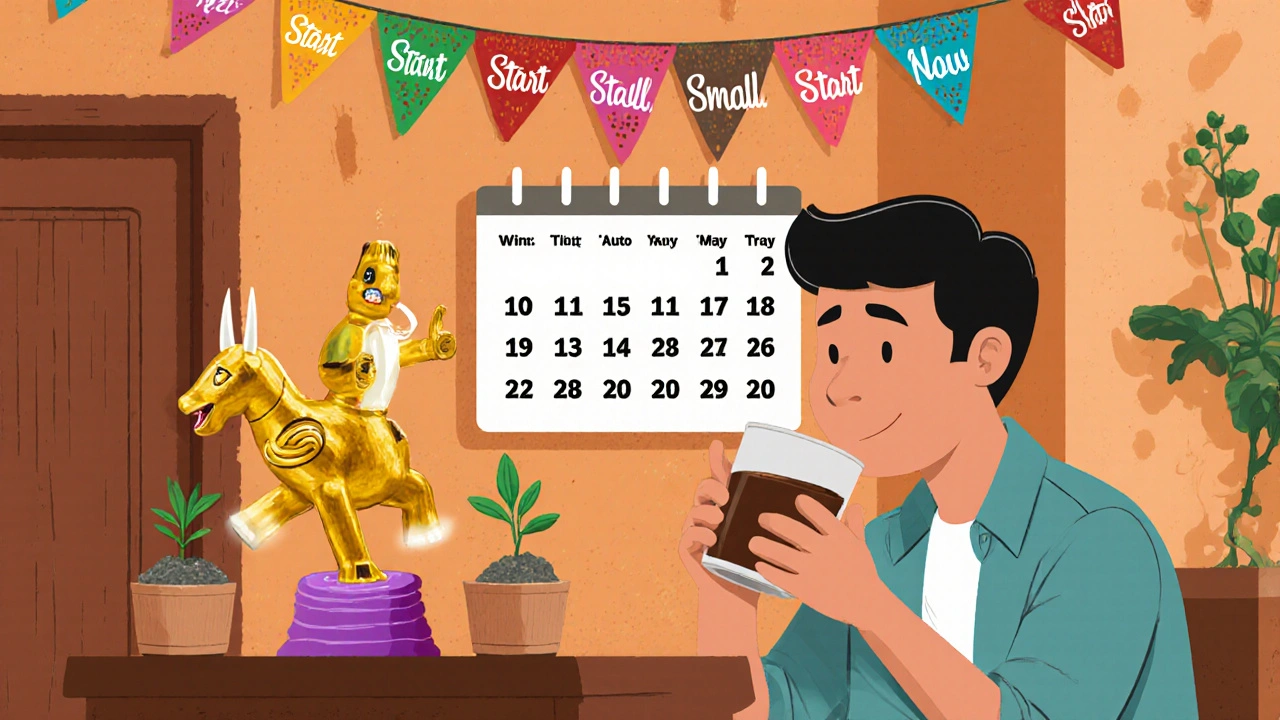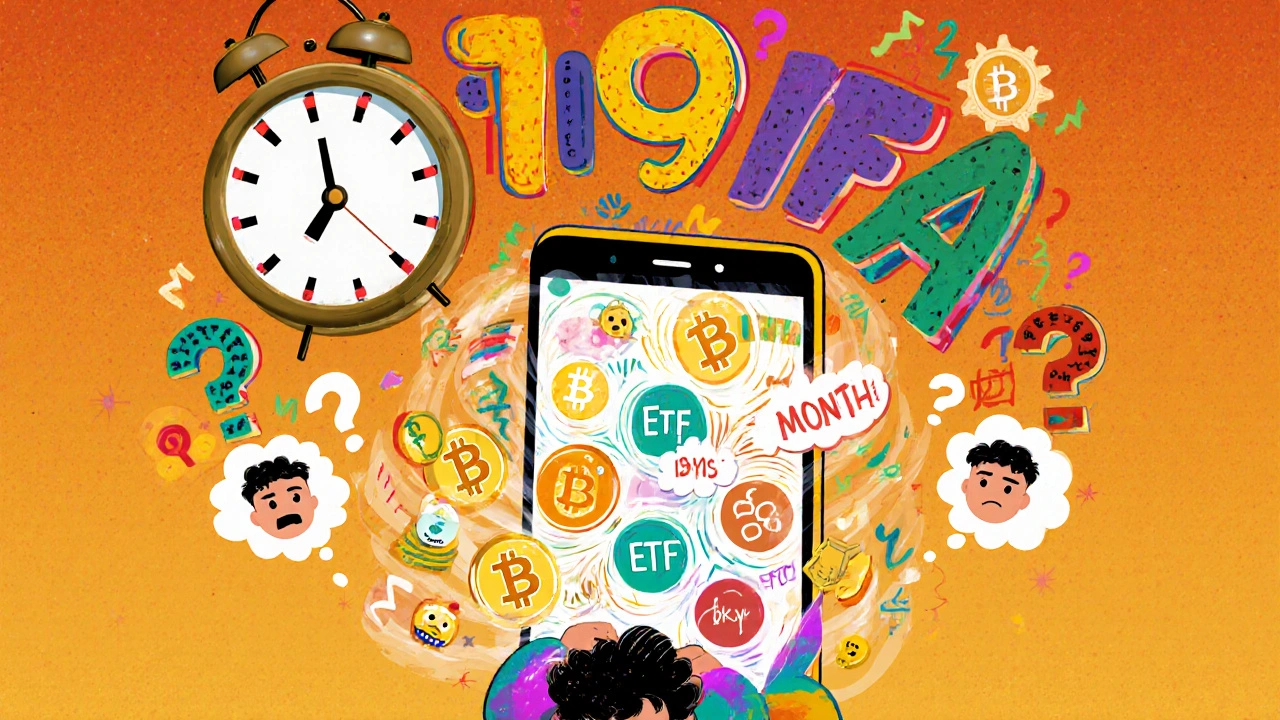Compound Growth Calculator
Start Investing Now
Your Growth Result
$0 invested over 0 months would grow to $0 at 10% annual return.
That's $ 0 you'd miss by waiting (Based on S&P 500 historical returns)
You’ve read the articles. Watched the YouTube videos. Scrolled through Reddit threads about ETFs, index funds, and crypto. You know you should invest. But every time you open your brokerage app, you freeze. What if you pick the wrong fund? What if the market crashes tomorrow? What if you’re too late? You’re not lazy. You’re not stupid. You’re stuck in analysis paralysis.
Analysis paralysis in investing isn’t just procrastination. It’s a mental trap. Your brain is drowning in options, fear, and conflicting advice. TD Bank found that over 68% of first-time investors delay starting because they’re overwhelmed. The average delay? Nearly 19 months. That’s almost two years of missed compound growth. If you’d put $500 into an S&P 500 index fund two years ago, you’d have over $600 today. Instead, you’re still researching.
Why You Can’t Decide (And It’s Not Your Fault)
The problem isn’t that you don’t know enough. It’s that you know too much-and none of it feels actionable. Three main things keep you stuck:
- Fear of losing money - 73% of new investors say this is their biggest blocker. The thought of losing even $10 feels catastrophic.
- No clear goals - If you don’t know why you’re investing (retirement? a house? freedom?), every choice feels meaningless.
- Too much noise - You’re getting advice from TikTok, your cousin, a financial influencer, and your boss. All of them contradict each other.
And it’s getting worse. Apps push you to “maximize returns.” Advisors tell you to “diversify properly.” Algorithms show you 12 different ways to invest $100. Your brain can’t process it all. So it shuts down.
Here’s the truth: You don’t need to know everything to start. You just need to know enough to take one small step.
The 5-Minute Investment Rule
TD Bank’s research shows that people who follow the 5-Minute Investment Rule are 78% more likely to keep investing long-term. Here’s how it works:
- Open your phone or laptop.
- Go to Fidelity, Charles Schwab, or Vanguard.
- Search for VTI (Vanguard Total Stock Market ETF) or VXUS (Vanguard Total International Stock ETF).
- Invest $50. That’s it.
- Click “Buy.”
You just spent less time than it takes to order coffee. And you just did something 92% of paralyzed investors never do: you acted.
VTI holds thousands of U.S. stocks. VXUS holds thousands of international ones. You’re not picking Apple or Tesla. You’re buying a piece of the entire market. It’s not exciting. But it works. Since 1990, the S&P 500 has returned about 10% a year on average. You don’t need to beat it. You just need to be in it.
This isn’t a “test.” It’s a learning investment. You’re not trying to get rich today. You’re trying to prove to yourself that you can make a decision and live with it.
Set Your Decision Thresholds
Before you research anything else, write down three non-negotiable rules. These are your filters. They cut through the noise.
Example:
- Expense ratio under 0.25%
- Minimum $1 billion in assets
- Diversified across 10+ industries
Now go back to your brokerage app. Type in “ETF.” Filter by those three rules. You’ll get maybe three options. That’s it. You don’t need 50. You need one.
When you set thresholds, you go from “What’s the best fund?” to “Which of these three works?” That’s a massive mental shift. It turns a paralyzing question into a simple choice.

Use the 20/80 Research Rule
Paralyzed investors spend 80% of their time researching and 20% acting. Flip that.
Set a timer for 2 hours. That’s your total research time for your first investment. Read one article. Watch one video. Read the fund’s fact sheet. Then stop. Use the other 80% of your time to actually invest.
Appinio’s study found that people who followed this rule reduced their paralysis from 8.2 months to just 2.1 months. Why? Because action builds confidence. Research builds fear.
You’ll never feel 100% ready. That’s not how it works. You feel ready after you start.
Automate It
The biggest reason people stay stuck? They think they have to make decisions every month. They don’t.
Set up an automatic transfer: $25, $50, or $100 from your checking account to your brokerage account every payday. Use Fidelity’s Auto-Invest, Charles Schwab’s Scheduled Investments, or even Acorns to round up your purchases.
GetMagical.com found that people who used automation reduced analysis paralysis by 84%. Why? Because you’re no longer deciding every time. You’ve already decided. Your money moves on autopilot.
Automation turns investing from a stressful chore into a quiet habit. Like brushing your teeth. You don’t think about it. You just do it.
Start Small. Start Now.
Here’s what success looks like:
- Sarah, a 28-year-old teacher, was stuck for 14 months. She started with $50/month in VTI. In 18 months, she had $3,278. She didn’t time the market. She just showed up.
- A company in Colorado ran a wellness program using the 20/80 rule. 401(k) participation jumped 37 points in one enrollment period.
- People using robo-advisors like Betterment or Wealthfront start investing 3.7 times faster than those doing it manually.
You don’t need to be rich. You don’t need to be smart. You just need to start.
That $50 you’re scared to invest? It’s not going to make or break you. But not investing it? That’s the real cost. Missed compound growth. Lost confidence. More stress.

What Happens After You Hit Buy?
Nothing dramatic. Your portfolio won’t explode. You won’t wake up rich. But something quiet changes.
You stop being a spectator. You become a participant.
Next month, you’ll check your balance. You’ll see a tiny gain. Maybe a tiny loss. You’ll realize: I’m still here. I’m still investing. That’s progress.
After three months, you’ll start noticing patterns. You’ll learn how markets move. You’ll stop fearing them.
After a year, you’ll have $600, $1,200, or $2,000 invested. And you’ll realize: I didn’t need to know everything. I just needed to start.
That’s the secret. Investing isn’t about perfection. It’s about persistence.
What If I Lose Money?
You will. Not because you made a bad choice. Because markets go down. Always have. Always will.
But here’s what no one tells you: The biggest risk isn’t losing $50. It’s losing time. The longer you wait, the more you lose to inflation, missed dividends, and compounding.
Historical data shows that even investors who bought at the worst times - right before a crash - still came out ahead over 10 years. The market doesn’t care if you’re nervous. It keeps going. You just need to stay in.
So if your $50 drops to $48? Good. You’ve learned that you can handle a small loss. That’s training. That’s growth.
Next Steps
Here’s your plan for the next 72 hours:
- Decide on your three investment rules (expense ratio, size, diversification).
- Open a brokerage account if you don’t have one. Fidelity, Schwab, and Vanguard all let you start with $0.
- Invest $50 in VTI or VXUS. Today.
- Set up an automatic transfer of $25 every two weeks.
- Do nothing else for 30 days. Just watch your balance grow slowly.
You don’t need to learn everything. You just need to start.
Analysis paralysis thrives in silence. It dies in action.
What’s the best investment for beginners?
There’s no single “best” investment, but the simplest and most proven option is a low-cost, diversified index fund like VTI (Vanguard Total Stock Market ETF) or VXUS (Vanguard Total International Stock ETF). These funds hold thousands of stocks across industries and countries, so you’re not betting on one company. They also have fees under 0.10%, which means more of your money stays invested. Over time, they’ve matched the market’s average returns - about 10% annually - without requiring you to pick stocks or time the market.
How much money do I need to start investing?
You can start with as little as $1. Many platforms like Fidelity, Charles Schwab, and Robinhood allow fractional shares, so you can buy a piece of an ETF for a few dollars. But psychologically, starting with $50 makes it feel real without being risky. The goal isn’t to invest a lot - it’s to build the habit. Once you’ve done it once, you’ll do it again.
Is it too late to start investing now?
No. The market doesn’t have a deadline. Waiting for the “right time” is how analysis paralysis keeps you stuck. Historically, the best time to invest was 20 years ago. The second best time is today. Even if you start with $25 a month, compounding will work in your favor over time. Someone who starts at 35 and invests $100/month will end up with more than someone who started at 25 but stopped after five years. Consistency beats timing.
Should I use a robo-advisor or manage my own investments?
Both work. Robo-advisors like Betterment or Wealthfront are great if you want hands-off investing. They pick funds for you, rebalance automatically, and help you stay on track. If you want to learn and control your choices, use a brokerage like Fidelity or Schwab and invest in ETFs yourself. The key isn’t which tool you use - it’s that you use one. Most people who start with robo-advisors eventually move to self-directed investing once they gain confidence.
What if I make a mistake?
You will. Maybe you’ll buy the wrong fund. Maybe you’ll sell during a dip. That’s okay. Every investor makes mistakes. The goal isn’t perfection - it’s learning. If you buy a fund and it drops, don’t panic. Wait. Look at the long-term trend. If you sold too early, just start again next month. Mistakes are part of the process. The only real mistake is doing nothing.
How do I know if I’m still stuck in analysis paralysis?
Ask yourself: Have you made a single investment in the last 6 months? Do you spend more than 5 hours a week researching instead of acting? Do you feel guilty or anxious every time you open your app? If yes, you’re still paralyzed. The fix isn’t more research. It’s one small action - like setting up a $25 automatic deposit. Action breaks the cycle.
Can I invest if I have debt?
Yes - but prioritize wisely. If you have high-interest credit card debt (above 7%), pay that off first. But if you have student loans or a mortgage at low rates (under 5%), you can invest and pay debt at the same time. The S&P 500’s long-term average return is around 10%. That’s higher than most loan interest rates. So even with debt, investing can still be a smart move - as long as you’re not ignoring high-interest obligations.

Laura W
November 1, 2025 AT 00:56Bro, I was stuck for 2 years. Literally. Then I did the $50 thing. Bought VTI. Didn’t even check it for 3 months. Came back and saw it had gone up. Felt like I won a tiny lottery. Now I auto-invest $100 every payday. No more doomscrolling. Just vibes. You don’t need to be a finance wizard. You just need to click buy and walk away.
Graeme C
November 2, 2025 AT 21:06Analysis paralysis is not a psychological phenomenon-it is a systemic failure of decision architecture. The sheer volume of conflicting heuristics presented by financial influencers, algorithmic content farms, and poorly contextualized historical data creates a cognitive overload that exceeds the bandwidth of the prefrontal cortex. The 5-Minute Investment Rule is not merely a heuristic-it is a behavioral nudge engineered to bypass the limbic system’s aversion to loss. VTI and VXUS are not investments; they are structural anchors in a sea of noise. You do not optimize. You stabilize. And then, and only then, do you compound.
Astha Mishra
November 3, 2025 AT 12:45You know, I used to think that investing was something only rich people or math geniuses could do… but reading this made me realize it’s more about courage than capital. I’m from a small town in India where talking about money is still taboo, and my parents always said, ‘Save in gold, not stocks.’ But I’ve been saving Rs. 1500 every month-about $18-and I just opened a brokerage account last week. I invested it all in VTI. I didn’t sleep that night. Not from fear… but from hope. Maybe I’m not smart enough to pick stocks, but I’m smart enough to trust the market. And maybe… that’s enough.
Kenny McMiller
November 5, 2025 AT 07:47Just bought VXUS with $50. Didn’t even read the prospectus. Just clicked ‘buy.’ Felt weirdly empowering. Like I finally stopped being a spectator. The market doesn’t care if you’re ready. It’s gonna move whether you’re watching or not. So now I’m setting up auto-deposits. No more ‘what ifs.’ Just ‘what’s next.’